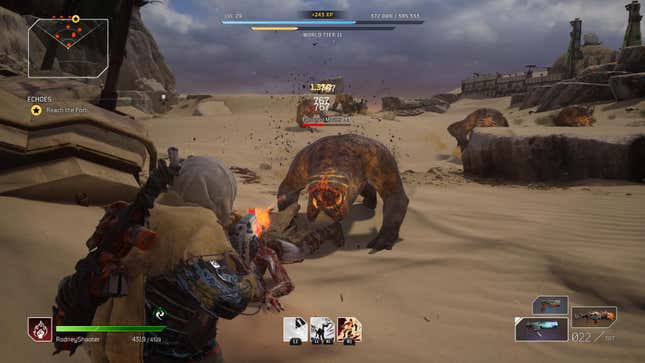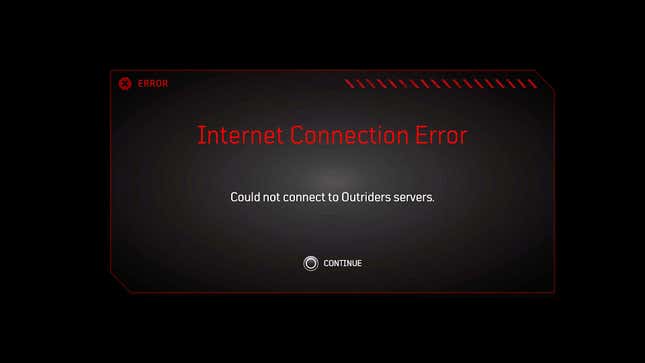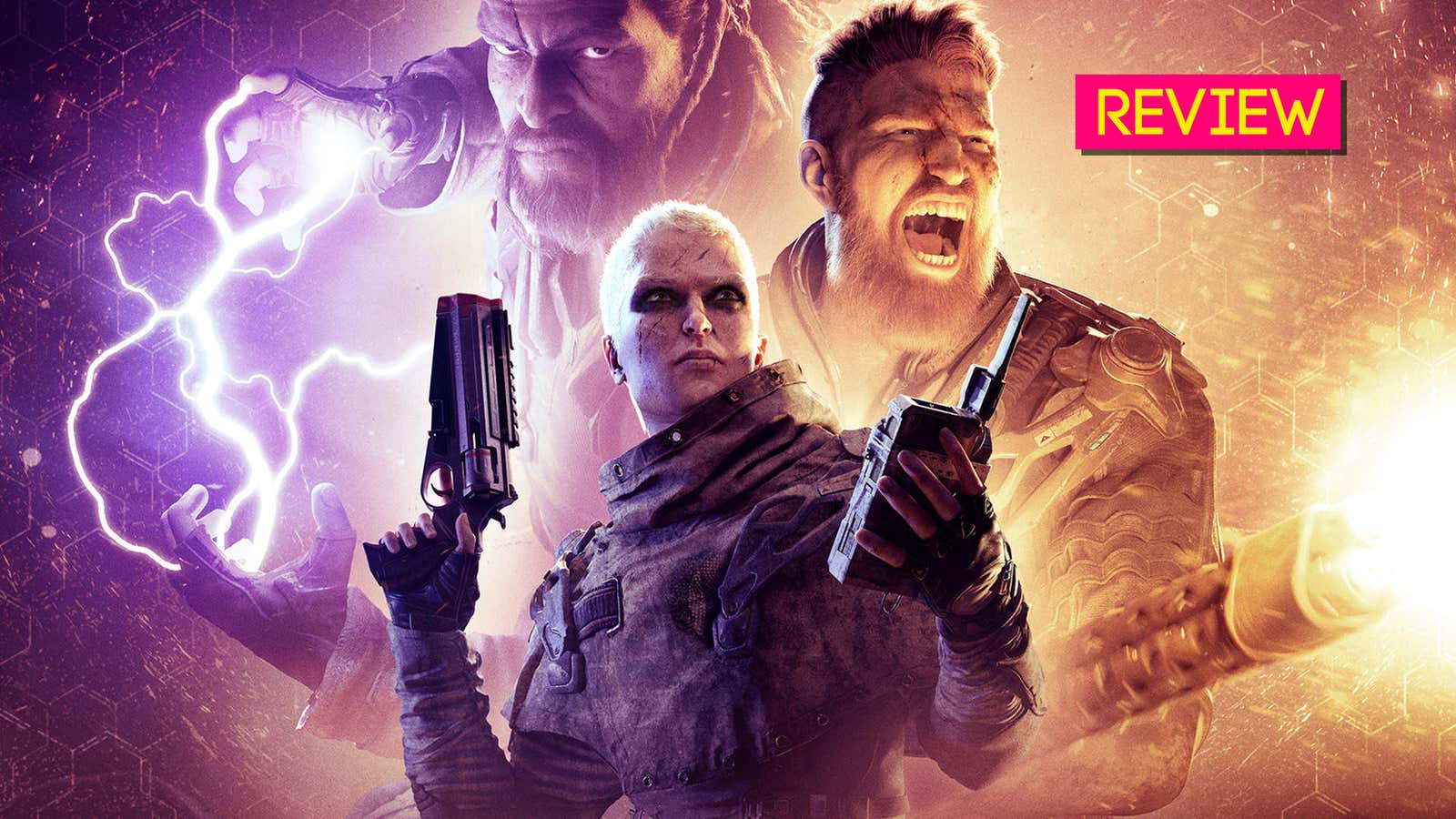Outriders isn’t what I was expecting. In the lead-up to launch, it looked like one more Destiny-like looter shooter to toss on the pile. But while it does have looting, shooting and even online co-op, Outriders isn’t just another live service game. In a lot of ways, it feels like an experiment to blend looter shooter mechanics with single-player design and hectic, old-school combat. It doesn’t completely succeed, but enough of it works that I want more.
Developed by Bulletstorm studio People Can Fly, Outriders is a third-person cover-based shooter that includes magic powers, tons of loot, and online multiplayer. But unlike nearly all other shlooters, there are no social hubs, PVP, or random encounters with other players. You can opt in to co-op action to play with a squad, or the entire campaign, including all side content, can be played perfectly well single-player. Playing alone, at least your first time through, lets you focus on and understand the story better and, with only a few exceptions, most missions and fights feel balanced for solo players.
You play as a nameless, badass Outrider, skilled soldiers who are sent into space alongside thousands of humans to colonize a new planet. Earth is dead, and this ship is humanity’s last hope. After 60+ years of flying through space while cryogenically frozen, your ship arrives at a planet called Enoch. As soon as you arrive, you’re nearly wiped out by a superstorm. You are one of the few survivors but are gravely injured and get chucked in a cryopod until they can fix you up. Nearly 30 years later, you wake up to a world that has become a nightmare.

On this new Enoch, deadly creatures are everywhere, humanity has splintered into warring groups and the storm you first encountered has gotten worse. But you wake up to find that you are one of the rare people who has been altered by the storm and now has superpowers. With your new powers, you quickly meet up with your surviving friends and share some information about a strange signal that could be the answer to saving Enoch and humanity. So you travel across the planet, meeting new friends and enemies, building up a crew to save the world.
You might be quick to roll your eyes or assume Outriders’ narrative is terrible, and it is, at least at first. The game starts off at a snail’s pace, set in brown and grey corridors with dull, generic soldiers as your first enemies. Quests are forgettable, mostly asking you to kill these boring enemies. The story is also messy, with tonally inconsistent writing. I suspect a lot of people will bounce off Outriders early on, but if you push through, things get a lot better. You leave the ugly corridors and visit vast snowy mountains, creepy swamps, and ancient jungles. During all of this, the narrative stays remarkably focused after the messy introduction, and the cast of characters you meet have fully developed arcs. Outriders isn’t an incredible masterpiece of storytelling, but compared to a lot of other games, it’s compelling.
As a superpowered Altered, you———- SERVER DISCONNECTED.

As you might have read about, Outriders is an always-online game. This is a bad decision for a game that feels so perfectly suited to solo play. It meant if my internet went down or if the servers collapsed, I lost access to the game. A few times I got kicked in the middle of missions or after fighting a big, tricky wave of enemies. It’s incredibly frustrating and a reminder that always online is rarely a good option, especially if your game can be played entirely solo. It also means you can’t freely pause the game, which is a problem for folks who have lives outside our consoles.
SERVERS BACK ONLINE——- RECONNECTING NOW
As a superpowered Altered, you have access to a whole bunch of cool abilities. There are four classes to choose from, and which class you pick determines which powers you get access to and can upgrade over the course of the game. I went with a Pyromancer, which allowed me to burn people up, gaining health in the process. I could also temporarily gain magma bullets, which also set people on fire. My personal favorite ability, Thermal Bomb, let me tag an enemy during battle, no matter if they were behind cover or above me, and if I killed them while they remained on fire and tagged, they would explode and kill others.
Other classes are similarly thrilling to play. The Trickster uses temporal energy to slow time and teleport around the battlefield. The Devastator, Outriders’ tank build, can reflect bullets and encase itself in stone armor. The Technomancer can drop turrets and trip mines, summon rocket launchers and miniguns out of thin air, and freeze enemies solid in a flash.
For the most part, the superpowers you have in Outriders, regardless of class, feel fabulous to use. They also have surprisingly short cooldowns, letting you spam powerful abilities across the battlefield. Another nice touch is at any point in the game you can respec your Altered skill tree and abilities, using the skill tree menu. If you get bored of a power or find a skill isn’t working for you anymore, just jump in there and change things up: Unlike other similar games, you don’t need coins or currency or materials to respec. It’s a smart design choice that takes away a lot of the early pressure of picking the wrong skill or upgrade. It also lets you have more freedom to tinker with everything your class can do.
Outriders isn’t just about firing off impressive powers; you also have a large selection of firearms and armor to collect and use. These items are useful, but not very exciting. Outriders’ gunplay isn’t bad, and weapons feel chunky and loud, but they lack the excitement of your superpowers.
As you get better gear and gain the ability to mod weapons and armor, things become more interesting. All gear in the game interacts with and often improves your skills and combat abilities. For example, I found an SMG that let me fire two of my Pyromancer’s Thermal Bombs before having to wait for the cooldown to start. Once your loot becomes worthless, as you find better stuff or level up, you can break it all down and strip the mods to put on better gears. It’s a fairly easy-to-understand system that has a nice amount of depth to it. I’ve built up a machine gun that heals me as I use it and burns foes at the same time, buffing other abilities and gear I have in the process.
By the end of the game, I was walking a death machine and was able to mostly rip through enemies, whether they were armed soldiers or mutant beasts. Late game tosses more and more enemies at you, leading to fights that feel less like Gears of War and more like Serious Sam. I enjoyed this a lot. The second half of the game, when it’s not tossing annoying snipers at you, is a lot more fun to play through than the beginning, as later missions assume you are more skilled and powered up.
If at any point the game gets too hard, you can drop the world tier. This is a system that slowly builds up over time, making the game spawn harder, more powerful enemies while giving you better loot. If you drop the world tier, the game lowers the level on all enemies, while letting you keep your more powerful gear, making fights easier. There were a handful of fights that pushed me to my breaking point, but instead of slamming my head against the game for hours, I just dropped the world tier a level or two, beat the fight, and raised it back up. Similar to modding and upgrading weapons, it’s an easy-to-use and effective system that lets anyone play, regardless of how skilled they are at shooters.

My time playing Outriders in co-op was great, but maybe too easy. I played with fellow Kotaku writer Ari Notis, and when the servers were working and we weren’t getting dropped from the game, I had a blast. I was a higher level, but the game tried balancing things so I wasn’t one-shotting bad guys. However, I still felt more powerful than I did when playing alone and could mow down bosses much faster than I think is intended. In co-op, all the cool powers and abilities synergize wonderfully, often without needing to plan in advance. For example, my Thermal Bomb became even more useful when Ari used his Trickster character’s ability to slow down time in a small part of the map. He would slow down a large group of baddies, and then I would tag one of them with my bomb skill. Ari would keep shooting them and hit the marked enemy, blowing up everyone in the bubble in a gory slow-motion explosion of death and destruction. It was fantastic, if a bit too easy. On higher world tiers I imagine this dance would still work, but not as effectively.
I wrapped up the main campaign of Outriders plus most of the side content after about 45 hours. After credits rolled, I entered the endgame. Here you complete harder missions in new areas to unlock better loot and more resources. I haven’t dug into this much, but it seems like more of the same as the main campaign. I plan to take a break and then probably return to play around with friends.
Outriders is a strange beast that won’t work for everyone, especially when the servers are down. But it mostly clicked with me. The use of looter shooter mechanics in a single-player experience with a solid narrative filled with fun, self-aware dialogue kept me playing even when fights got a bit annoying or missions were too long. Outriders isn’t a new Destiny or Warframe, and that’s fine. I’m happy that Outriders tries to be something different and more self-contained. It might limit its longevity, but it was nice to play something that was an adventure and not a treadmill covered in bad loot and battle passes.
.
